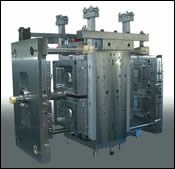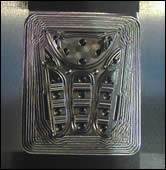In-Mold Labeling Looks to High-Output Molds for Growth
Moldmakers seek to combine ultrafast cycles and high-speed automation in tool designs.
In-mold labeling of injection molded parts has great potential in North America. In packaging especially, the process improves the aesthetics and appeal of containers and lids, differentiates products at retail from less-attractively-packaged goods, and because it's not yet in the mainstream, provides an important competitive upgrade to moldmakers as well as molders. Tool builders who design and fabricate molds for the types of high-speed, high-precision in-mold labeling (IML) operations typical in packaging can virtually assure themselves of access to a growing market sector.
That being said, IML injection molds for packaging are a tough nut to crack when it comes to design and engineering. While the basics of moldmaking like specification of metals and components are similar to tools for other applications, IML poses major fabrication challenges that must be addressed for molds to operate productively. Chief among these is integration of automation and protection of labels during molding.
The design and engineering challenges are formidable, as are the payoffs. IML not only improves the aesthetics of a package but eliminates costly downstream operations like printing. Some observers say it may enable concepts in package design that only require a label change during molding to give a product a new look rather than a total redesign. The process also permits placement of decorative plastic labels on non-plastic lids and containers such as those made of paperboard, and can be used to cover containers with metallic foil to give them the look of glossy high-end metals like aluminum and silver.
The technology, of course, isn't new—it's been around for at least 25 years. But interest is growing for the competitive benefits it provides. "In the last year I've had more inquiries about in-mold labeling than in the previous five years," says Lisa Mauro, U.S. Sales Engineer for moldmaker Foboha (Hamburg, NJ).
Moreover, IML's penetration of the North American market for injection molded packaging is low, about 5 percent. Major growth is forecast for the process, but only if the design of higher-cavitation molds and accompanying automation can be perfected, a move that's underway, notably in the area of stack molds, which lead the market in IML packaging.
Rush to Higher Cavitation
Due to the volumes required for cost-effective molding of packaging, stack molds or variants make the most sense when it comes to IML. Experts claim, however, that capacity is the main factor limiting the use of the process in North America. "One of the impediments to the growth of injection molded IML containers in the U.S. is the fact that there isn't an adequate number of stack molds to do the job," says Ronald Schultz, Executive Director of the In-Mold Decorating Assn. (Scottsdale, AZ) "There is a need for significant cavitation. Moldmakers and robotics manufacturers are working to improve the available volume, but it's slow in coming."
Higher cavitation, in turn, will affect automation. As throughput increases, moldmakers need to design molds as much for high-speed robotic systems as for production. A 2 X 16 stack mold, among the largest in use for IML, means 32 cavities are opening at the same time with the need to place labels accurately, usually in fractions of a second, Schultz notes. "That's a big challenge."
High-volume production of IML parts differentiates the North American market from Europe, where the process is much more common. Experts say that 97 percent of the IML packaging market in Europe is injection molding. (The balance in both regions is blow molded containers.) Europe as a whole may generate similar IML packaging demand as North America, but the difference is that production runs are much shorter, primarily because of the need to change labels for national markets. Thus, while a European packaging company might order 10 million IML containers for an item, production could be split up into five or more runs to accommodate different labeling needs. In North America, with few exceptions, an order for 10 million IML containers could be produced in one operation, even on one machine. For this reason, it's not uncommon to see relatively small 2 X 4 or 2 X 8 stack molds in Europe, or even single-face molds with four to eight cavities.
Stack mold builders are pushing the design envelope in North America in an effort to develop IML tooling with record-high cavitation. StackTeck (Brampton, ON), which has built a 2 X 16 IML mold for lids, one of the largest in North America, has quoted on 2 X 32 and 4 X 12 designs, also for lids, says Jordan Robertson, General Sales Manager. A 4-level mold would be of interest to many packaging companies, he believes, since they are used in operations where lids and containers are printed downstream, and thus have injection machines and molding cells sized for their output. Consolidating secondary operations in one process would be a compelling economic benefit.
Many packaging companies, however, don't readily appreciate the benefits of IML, primarily because the process carries an inherent penalty in the time required to insert labels and demold parts. While for some applications this is measured in fractions of a second with the most advanced automation systems, it is still viewed by end-users as a drag on productivity. "The worst thing you can do to a packaging company is slow it down," says Brian Graham, President of IML by iDesign (Lodi, OH), a molding systems integrator.
Design for Automation
Successful integration of automation is as much a function of mold design as of robot performance. Toolmakers must take this into account at the start of the design process. "It's important that a moldmaker consider that the automation has to be placed together with the mold to get it to work properly," remarks Bernd Schrenk, Managing Director of Männer Group (Bahlingen, Germany, and Norcross, GA).
Work is underway by automation suppliers and moldmakers to reduce the amount of time necessary for IML insertion and demolding. Among leading suppliers of robotic systems for IML are CBW Automation (Fort Collins, CO), Wittmann Inc. (Torrington, CT), SAS Automation Systems (Xenia, OH) and Yushin America (Cranston, RI).
Basic considerations in tool design include leaving enough daylight during mold opening to allow robots to insert labels and demold parts. It's an obvious point, but as John Westbeld, Engineering Manager at SAS Automation, notes, "A lot of moldmakers don't design molds with automation in mind." Westbeld and others advise that collaboration among different suppliers, including label producers, is essential from Day 1 to assure that IML molds work as specified.
Though custom automation systems are available, most IML robots can be specified from standard lines. "In-mold labeling, per se, has no other impact on robot selection than possibly the use of double-acting, end-of-arm tooling (EOAT)," says Michael Wittmann, CEO of Wittmann. Nor do requirements change much for stack molds, which he says usually need two or more independent side-entry robots.
Side-entry robots generally provide the fastest response times for IML. The size of the molding machine, weight and dimensions of the robot's EOAT, cycle time and the anticipated time needed for label insertion and part removal are factors that determine what type of robot should be specified, Wittmann notes. "The biggest influence on the selection of the robot is cycle time," which typically is 5 seconds or less.
Among the side-entry robots that Wittmann produces for IML, model W727H is a modular unit that can be equipped with two horizontal axes for stack molds. It operates with a cycle time of 2.5 seconds. The other is model W7x5, which has removal speeds as fast as 0.2 seconds on a 300mm. stroke, or about 12 inches. The stroke might be too short for some of the high-cavitation stack molds in development, but it shows how little time high-speed robots add to molding cycles.
Wittmann last year acquired French moldmaker Regad, a specialist in thinwall parts, to increase its understanding of mold design and labels, and to improve development of turnkey automated IML systems.
High-speed automation is key to maintaining fast cycles with stack molds, but two moldmakers tout innovative rotating-cube designs that they claim achieve volume production without blazing operation of mold or robots. Gram Technology (Scottsdale, AZ) utilizes a "Spin Stack" mold and Foboha features its "Turning Stack" mold. While the two are different, and patented, they also have similar features. Both rotate horizontally in 90-degree increments. At each turn an operation—label insert, molding, part cooling, demolding—occurs. The result, both companies say, is a less complicated operation that meets IML production needs.
Jes Gram, Owner of Gram Technology, says that because the molding cycle is divided into four incremental movements, robots have more time to insert labels on one side of the cube, and visually inspect the label and the finished part to make certain everything works as specified. Since parts remain in-mold longer, cooling time increases prior to removal.
"We have full stack-molding capabilities," says Gram. "But the mold doesn't need an enormous opening stroke to demold parts. It only opens enough for the core to spin, about a third of the opening on a conventional mold."
Mauro says that with the Turning Stack mold, labels are applied to the rear of the cube after the mold clamps shut on the opposite side to form parts. A robot can thus take the full molding cycle to insert labels rather than do it in a fraction of the time as with conventional molds.
"We believe the cube molds are advantageous for IML because you minimize the complexity of automation," she says.
Precision Alignment
Whether molders opt for cube molds or stack molds, precision operation is an important issue, especially with the degree of automation that's involved. Part geometry in particular needs to be addressed when developing the mold to make certain that a container's shape won't affect automation or the placement of labels, and that internal components like cores and pins assure the proper alignment of labels and parts during molding.
Wittmann says that if food containers with raised bottoms or narrow wedges are to be molded, inner cores should retract during insertion so labels don't get tangled up. To assure repeatable placement in cavities, it helps to insert pins in cores to maintain label position during mold closing. Robertson at StackTeck advises that alignment features should be designed into both the robot mandrels that transport labels and the mold cavities for precise positioning.
Labels are usually held in cavities by one of two methods: an electrostatic charge or vacuum. The static charge, the most common, is applied by the robot and "forces" the label to lie in a cavity. The vacuum is an internal mold system, common in IML blow molding operations, which holds a label flush during molding. If designed in from the beginning, it's relatively easy to set up and manage, according to Schultz. If it's done as an afterthought, it can affect areas like mold cooling and maintenance of the vacuum. A vacuum system has multiple ports and a screen to support labels. If labels are offset printed, the powder used in the process to separate labels as ink dries will be trapped by the vacuum unit and clog it up. The same is true of some inlays—shaped labels that conform to 3-D parts—that carry dust from die-cutting operations. Both situations are manageable if moldmakers adjust designs accordingly.
One of the most important requirements is protecting labels during molding. High shear rates and the improper placement of components like hot tips can damage or destroy labels. Robertson says a good approach for IML is to use valve gates sized for a low shear rate in place of hot tips. "If you run a valve gate with high shear and the label is immediately opposite, you're going to wash it away."
Cooling design is also critical to label integrity and, of course, product quality. Robertson says that in testing molds StackTeck has built, label discoloration caused by heat buildup sometimes occurs. When it does, changes to the cooling layout of the mold eliminates the problem. Robertson declines to detail the changes, saying they involve proprietary design techniques.
One way to protect a label from being dislodged or damaged by melt flow won a U.S. patent late last year for IML by iDesign. The technique, called "Label Ledge," involves installing a ledge or undercut of the same thickness as the label in a cavity wall to protect the leading edge of a label from melt flow. This forces resin to flow over the ledge, in the process pinning the label to the cavity wall exactly where it should be. Graham says the technique reduces scrap, and can be used to retrofit old molds as well as on new molds.
Summary
The broad use of IML in the blow molding of consumer packaging for laundry detergents, personal-care products, food and other goods shows how effective the process is at creating durable, attractive containers that are eye-catching and practical. Moldmakers who work closely with automation suppliers, label producers and end-users will acquire the expertise necessary to develop the breakthrough designs and engineering features that lift production levels in North America to rates that sustain growth and move the technology into the mainstream.
Related Content
Solving Mold Alignment Problems with the Right Alignment Lock
Correct alignment lock selection can reduce maintenance costs and molding downtime, as well as increase part quality over the mold’s entire life.
Read MoreRevisiting Some Hot Runner Fundamentals
What exactly does a hot runner do? If you’ve been in the injection molding industry for any length of time, you might think the answer is obvious, but it is not.
Read More6 Ways to Optimize High-Feed Milling
High-feed milling can significantly outweigh potential reliability challenges. Consider these six strategies in order to make high-feed milling successful for your business.
Read MoreRead Next
Moldmakers Counter Offshore Sourcing with State-of-the-Art Capabilities
Advanced engineering and mold building techniques give North American toolmakers entrée to emerging electronics applications.
Read MoreMold Builders Carve Lean Niche
Commodity-oriented consumer manufacturing left North America, but mold industry survivors are finding strong growth in technical market sectors.
Read MorePackaging Molds Go High-Tech to Improve Productivity and Economy
The ability to design and build innovative molds for advanced processing needs is key to being competitive and profitable in a low-margin market.
Read More

























